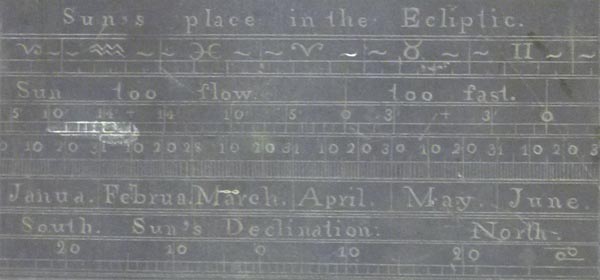1839
Diptych Sundial
A diptych sundial from Co. Monaghan, dated 1839
By Noel Campbell
This sundial consists of two slate faces at right angles to one another with a gnomon joining the centre of the two faces. The slates are set in a moulded wooden frame and measure 22cm in diameter each. Incised on the dial of one are 14 concentric circles. The centre circle of the dial is occupied by a compass card arrangement indicating the various directions. Twenty locations from around the world have also been inscribed on this slate. Engraved along the second band are Roman numerals from I to XII. Spaces between some of the circles have been designated half hour, five and one minute sections.
The second or vertical slate has nine concentric rectangular figures. Written in the smallest of these figures are the Roman numerals from I to XII. Incised on the fourth band are lines dividing the spaces into hours and half hours. The next two bands divide time into 5 minute and 1 minute sections. Two tables show the "Sun’s place in the Ecliptic". Two inscriptions on this slate read "Meridian Line 1839 By Patrick Farrelly Oct II and Evylin Shirly Esq & & Shirly Castle". The bronze gnomon has one straight side while the other side which is broken has a pattern in outline.
How did this sundial work?
Diptych dials like this one which have two distinct sundials, a horizontal one and a vertical direct south dial, were used to tell the time of day. Before the pocket watch became commonly accessible in the nineteenth century, the sun was used to measure time. The sun was utilised in this manner as early as 3,200 BC when solar alignments incorporated into the structure at Newgrange, Co. Meath were used to indicate the winter solstice and time of year. The premise behind all sundials is that the sun will shine on the gnomon with the resulting shadow falling on a number on the slate which will indicate solar time.
What is Dial Furniture?
The lines and figures on the sundial which are used to tell the time of day and are considered the essential component of the instrument. All other lines, figures and etchings are considered dial furniture. This sundial has a considerable amount of intricate dial furniture on both slates which includes the "Sun’s place in the Ecliptic" (the ecliptic being the path of the sun in the sky) and the "Equation of Time" table which indicates by how much the dial is "fast" or "slow". The displaying of time in other cities is also a common feature of dial furniture.

Fig. 2: Sundial furniture
Learn more…
The National Museum of Ireland - Country Life holds an extensive collection of sundials in its reserve collection which is not open to the public.
Read more...
You can find more information in the following:
-
Daniel, Christopher St J. H., Sundials, Princes Risborough: Shire Publications Ltd., 1986.
-
Lennox-Boyd, Mark, Sundials: History, Art, People, Science, London: Frances Lincoln Ltd., 2006.
-
Waugh, Albert E., Sundials: their theory and construction, New York: Dover Publications, Inc., 1973.
Suíomh:
Diptych Sundial suite ag:
In Storage
An déantán roimhe seo:
Cuneiform Tablets: the Genesis of Documentation
An chéad déantán eile:
